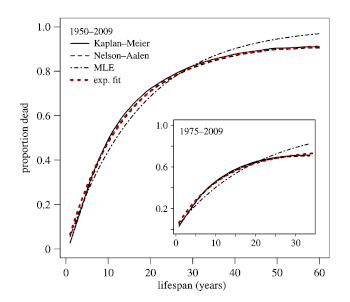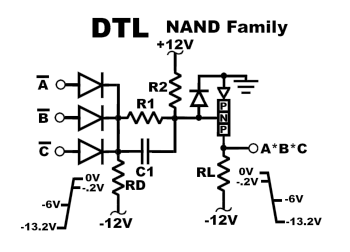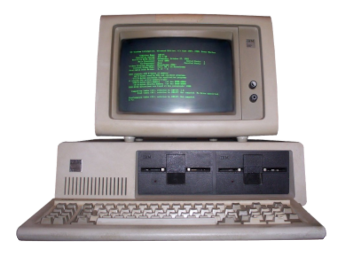100 Years of IBM
May 6, 2024
There are considerable
statistics on
human life expectancy.
Men in the
United States are expected to live 76 years, and
women are expected to live nearly 81 years. These are actually lower than for many
countries in the world with the
United States ranking seventy second in life expectancy. The country with the highest life expectancy is
Monaco with men living 85.70 years and women living 93.49 years. But, what about the life expectancy of a
company?
Scientists at the
Santa Fe Institute (Santa Fe, New Mexico) published a
study in the
Journal of the Royal Society Interface that found that the
half-life of a
publicly traded company is about a
decade before it
merges, it's
bought out, or gets
liquidated.[1-2] The
researchers examined
data in
Standard and Poor's Compustat, a comprehensive
database of more than 25 000 publicly traded
North American companies, from 1950 to 2009.[1-2] This ten year half-life does not depend on
business sector.[1-2]

Company mortality versus lifetime (Daepp, et al. 2015).[1]
The mortality function closely follows an exponential curve based on a constant hazard rate.
(Fig. 4 of ref 1, released under the Creative Commons Attribution License. Click for larger image.)
In general, smaller companies grow quickly, while the
sales of older companies
plateaued as they reached
maturity.[2] The research team found that a company's risk of dying in the next year was not
correlated with its
product or how long it had been in
business.[2] While the study didn't examine the reasons for this trend, they
conjectured that companies, like
Living organisms, must
compete for scarce resources to survive.[2]
Other research shows that the lifespan of an
S&P 500 company has decreased from 67 years in the
1920s to just 15 years today.[3] Interestingly,
Japan, a country that ranks fourth in human life expectancy, is host to some of the oldest companies in the world.[3] Japan has more than 20,000 companies that are more than a
100 years old, and a few that are more than a thousand years old.[3] For companies,
innovation and
reinvention are the most important factors for survival.[3]
Startups will often
pivot from their initial business idea.
Nokia, a
cellphone and
telecommunications equipment manufacturer, started as a
pulp manufacturer; and,
Berkshire Hathaway, started as a
textile mill in
Rhode Island.[3]
The
International Business Machines Corporation (IBM) is a company with significant longevity.
James W. Cortada, a
senior research fellow at the
University of Minnesota's Charles Babbage Institute who worked at IBM for 38 years in various positions, has written an
article in
IEEE Spectrum about the origin of IBM.[4]
Back in the
late 19th century, business equipment such as
adding machines,
cash registers, and
weight scales were in increasing demand, as were
time clocks for
logging the hours of
manufacturing employees.[4] A 1911 merger of several companies in these
markets resulted in the creation of the
Computing-Tabulating-Recording Company (C-T-R).[4] In 1914,
Thomas John Watson Sr. (1874-1956) was hired by C-T-R to increase sales.[4] Watson had worked for twenty years at the
National Cash Register Company, which was considered to be one of the best
managed companies at that time.[4]
Under Watson, C-T-R
revenue grew from $4 million in 1914 to $14 million in 1920.[4] In February, 1924, International Business Machines became a
New York corporation taking over business and
assets of the Computing-Tabulating-Recording Company.[4]
Thomas John Watson Jr. (1914-1993) joined his
father's company in 1937, but his
tenure was interrupted by
World War II when he served as a
pilot in the
Army Air Forces. Watson returned to IBM in 1946 with a renewed
confidence brought about by his
military service, becoming
Executive Vice-president in 1949,
president in 1952, and
CEO just days before his father's
death in 1956.
Watson was wholeheartedly committed to the production of
mainframe computers, which had been a low
profitability product for IBM. There were numerous
technology advancement made by IBM before Watson left in 1971 after having a
heart attack. I've listed many of these that I've judged to be the most important.
• The IBM 701 Commercial Computer, introduced in 1952, was the first mass-produced large-scale electronic computer.
• The IBM 650 Magnetic Drum Data-Processing Machine, also introduced in 1952, was a popular intermediate-sized electronic computer for scientific and business applications.
• The IBM 350 disk storage unit, introduced in 1956, was the first magnetic hard disk for data storage. It stored five million six-bit characters on fifty-two 24-inch diameter disks. The storage capacity was 3.75 megabytes.
•
IBM embraced FORTRAN as a programming language in 1957.

A diode-transistor-logic (DTL) NAND gate built from a PNP transistor in 1959.
As can be seen, IBM had an unique way of representing transistors at that time.
(Wikimedia Commons image/ Click for larger image.)
•
IBM introduced The IBM 1401, the first mass-produced transistorized computer in 1959. It featured a magnetic core memory and stored program capability.
• The IBM System/360 was announced on April 7, 1964. It was a configurable general purpose mainframe computer system that used interchangeable software and peripherals, such as printers and magnetic tape data storage. The System/360 became the dominant mainframe computer of its time.

A keyboard that only a mathematician would love. This is the layout of the IBM APL keyboard. APL was the timeshare interpretive programming language of the IBM System/360 and System/370. APL was principally created by computer scientist, Kenneth E. Iverson (1920-2004). (Via Wikimedia Commons.)
The announcement of the System/360 was coincident with the invention of vaporware. Some System/360 components in publicity photographs were actually wooden mockups. There was a popular joke about this in technology circles - "Why do women avoid marrying IBM salesmen? In the first year of marriage, the salesmen just sit at the side of the bed and explain how wonderful it will be when it finally happens."
•
IBM invented the one-transistor dynamic random-access memory (DRAM) memory cell in 1966.
• To defuse some of its antitrust problems, IBM unbundled software and services from its hardware in 1969.
•
IBM announced its System/370, the successor to System/360, in 1970. As a consequence of the popularity of its System/360 and System/370 mainframes, IBM sold 80% of computers in the U.S., and 70% of computers worldwide in the 1960s and 1970s.
• IBM introduced relational databases in 1970.
•
Just after Watson's departure, the IBM Personal Computer was introduced in 1981. This event proved more of a boon to Microsoft and PC-compatible manufacturers than to IBM. IBM sold its personal computer business to Lenovo, a Chinese company, in 2005.

IBM PC 5150 with a 5151 green monochrome monitor. This computer is running MS-DOS 5.0.
I once had a CP/M computer with an amber (P3 phosphor) monochrome monitor. I can still remember that soothing display color.
(Wikimedia Commons image. Click for larger image.)
•
The United States antitrust lawsuit against IBM was dismissed in 1982 as being without merit. This suit was initiated in 1969, and it spawned another popular joke in its early years - "An IBM engineer invented a time machine. To prove that it worked, he travelled to a date in the far future. When he returned, his colleagues asked him about the first thing he did in the future. He responded that he bought a newspaper to check the status of the IBM antitrust lawsuit."
•
In 1998, IBM introduced the first microprocessor with a GHz clock rate.
Beginning in the 1990s, IBM began
downsizing operations,
divesting some operations, such as its personal computer division, and concentrating on computer services, software,
supercomputers, and scientific research. In 2001, IBM became the first company to produce more than 3,000
patents in one year; and, in 2008 achieved 4,000 patents. In its lifetime, IBM has been issued more than 150,000 patents. Among its innovations, IBM introduced the
floppy disk, the
magnetic stripe card as found on
credit cards, and the
Universal Product Code (UPC) barcode. IBM scientists arranged 35
xenon atoms in a
scanning tunneling microscope to spell "IBM" in 1990. IBM has had five
Nobel Physics Laureates that include
Leo Esaki (b. 1925) in 1973 for his invention of the
tunnel diode,
Gerd Binnig (b. 1947) and
Heinrich Rohrer (1933-2013) in 1986 for the scanning tunneling microscope, and
Georg Bednorz (b. 1950) and
Alex Müller (1927-2023) in 1987 for the discovery of
high temperature superconductors.
References:
- Madeleine I. G. Daepp, Marcus J. Hamilton, Geoffrey B. West, and Luís M. A. Bettencourt, "The mortality of companies," J. R. Soc. Interface, vol. 12 (May 5, 2015), Article no. 20150120, https://doi.org/10.1098/rsif.2015.0120, This is an open access article with a PDF file at the same URL.
- Susan Thurston, "The Typical Lifespan of a Business, According to Science," Business Administration Information, April 8, 2015.
- Kim Gittleson, "Can a company live forever?," BBC News, January 19, 2012.
- James W. Cortada, "100 Years Ago, IBM Was Born," IEEE Spectrum, February 13, 2023.
Linked Keywords: Statistics; human life expectancy; men; United States; women; sovereign states; countries in the world; United States ranking seventy second in life expectancy; Monaco; company; scientists; Santa Fe Institute (Santa Fe, New Mexico); scientific literature; published; research; study; Journal of the Royal Society Interface; half-life; publicly traded company; decade; mergers and acquisitions; merge; bought out; liquidation; liquidated; researchers; data; S&P Global Ratings; Standard and Poor's; Compustat; database; North America; North American; business sector; Company Longevity (Daepp, et al. 2015); mortality; lifetime; function (mathematics); exponential function; exponential curve; constant (mathematics); survival analysis; hazard rate; Creative Commons Attribution License; sales; plateau principle; plateaued; maturity; correlated; product (business); business; conjecture; living organism; survival of the fittest; compete for scarce resources to survive; 1920s; Japan; century; 100 years; innovation; reinvention; startup company; pivot; Nokia; mobile phone; cellphone; telecommunication; electronics; equipment; manufacturer; pulp (paper); Berkshire Hathaway; textile manufacturing; textile mill; Rhode Island; International Business Machines Corporation (IBM); James W. Cortada; senior research fellow; University of Minnesota; Charles Babbage Institute; academic publishing; article; IEEE Spectrum; late 19th century; adding machine; cash register; weight scale; time clock; logbook; logging; manufacturing; employment; employee; market (economics); Computing-Tabulating-Recording Company (C-T-R); Thomas John Watson Sr. (1874-1956); NCR Voyix; National Cash Register Company; management; manage; revenue; New York; corporation; asset; father; tenure; World War II; aircraft pilot; United States Army Air Forces; confidence; military service; executive Vice-president; president (corporate title); chief executive officer; CEO; death; mainframe computer; profit (accounting); profitability; technology; myocardial infarction; heart attack; IBM 701 Commercial Computer; mass production; mass-produced; electronic computer; IBM 650 Magnetic Drum Data-Processing Machine; science; scientific; IBM 350 disk storage unit; hard disk drive; magnetic hard disk for data storage; bit; character (symbol); inch; diameter; disk; FORTRAN; programming language; IBM DTL PNP Gate; diode-transistor-logic (DTL); NAND gate; bipolar junction transistor; PNP transistor; transistor; Wikimedia Commons; IBM 1401; transistor; transistorized; stored-program computer; IBM System/360; interchangeable parts; computer software; peripheral; printer (computing); magnetic tape data storage; computer keyboard; mathematician; love; APL (programming language); time-sharing; timeshare; interpreter (computing); System/370; computer scientist; Kenneth E. Iverson (1920-2004); invention; vaporware; publicity; photographs; wood; wooden; mockup; joke; marriage; marrying; bed; dynamic random-access memory (DRAM); memory cell (computing); competition law; antitrust; 1960s; 1970s; relational database; IBM Personal Computer; boon; Microsoft; PC-compatible; Lenovo; China; Chinese; IBM PC 5150; IBM 5151 green monochrome monitor; MS-DOS 5.0; CP/M; standard phosphor type; amber (P3 phosphor); engineer; time machine; future; colleague; newspaper; microprocessor; GHz; clock rate; layoff; downsizing; divestment; divesting; supercomputer; patent; floppy disk; magnetic stripe card; credit cards; Universal Product Code (UPC); barcode; xenon; atom; scanning tunneling microscope; Nobel Physics Laureate; Leo Esaki (b. 1925); Esaki diode; tunnel diode; Gerd Binnig (b. 1947); Heinrich Rohrer (1933-2013); Georg Bednorz (b. 1950); Alex Müller; high temperature superconductor.